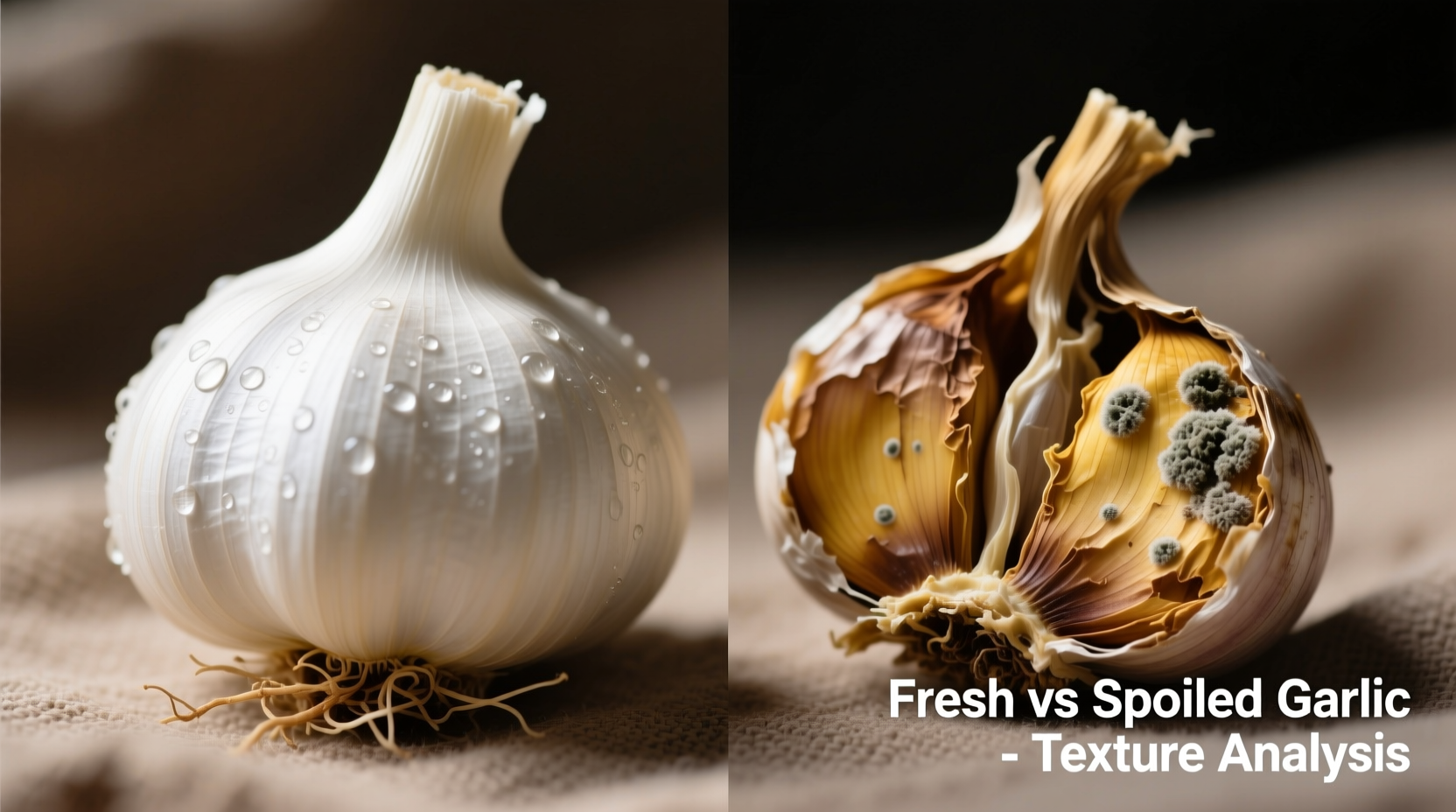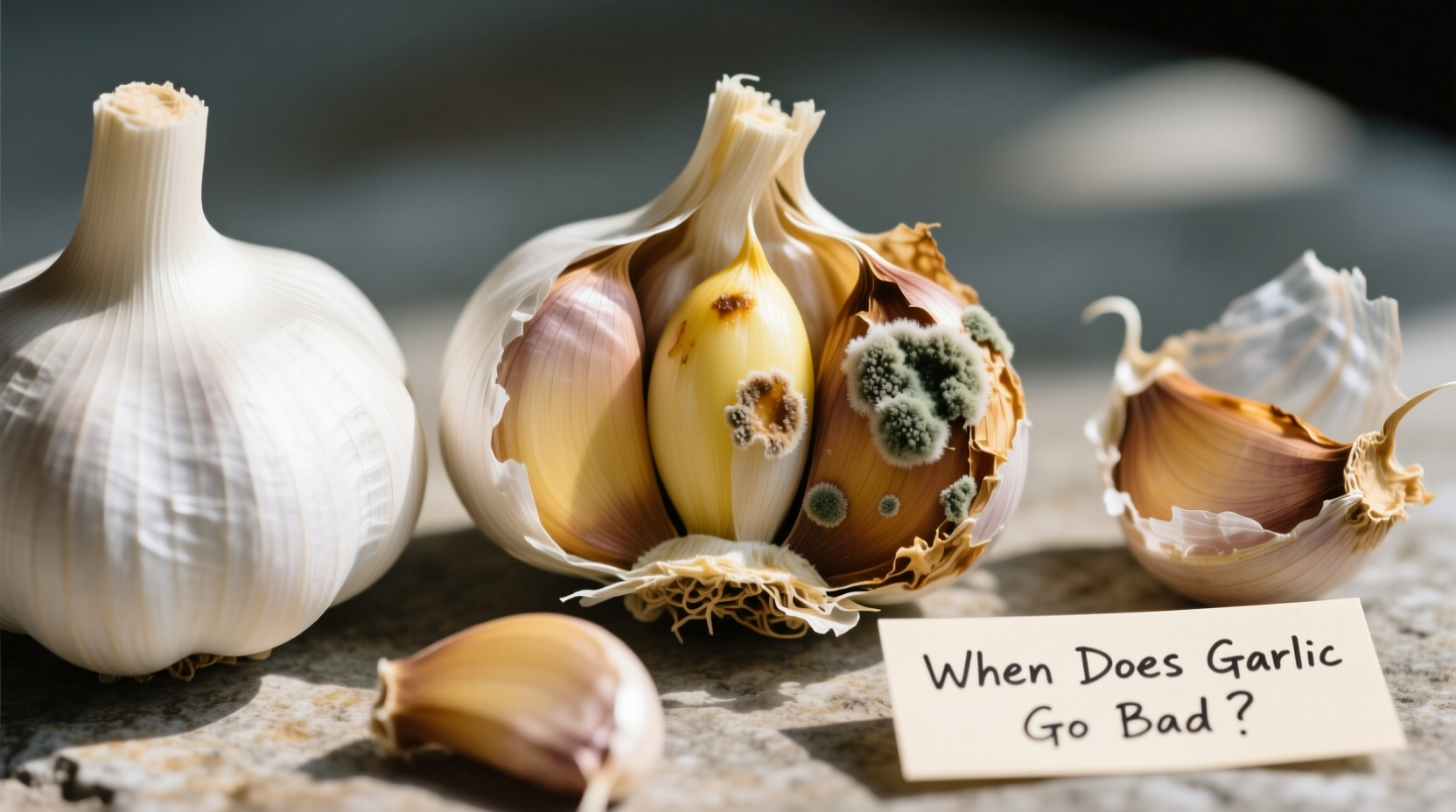Whole garlic bulbs stay fresh for 3-6 months when stored properly in a cool, dry place. Individual cloves last 7-10 days, while minced garlic only keeps for 5-7 days refrigerated. Discard garlic immediately if you notice mold, soft spots, or a sour smell - these indicate spoilage that could cause foodborne illness.
Ever pulled out garlic for your favorite recipe only to wonder when does garlic go bad? You're not alone. Nearly 40% of home cooks have questioned garlic freshness before cooking, according to USDA food safety surveys. Getting this wrong doesn't just ruin your dish - spoiled garlic can cause serious foodborne illness. Let's cut through the confusion with science-backed guidance you can trust.
How to Spot Bad Garlic: The 4-Point Inspection Method
Professional chefs use this quick visual and sensory check before every use. Don't skip these critical indicators:
- Color changes: Brown or yellow spots indicate early spoilage; green sprouts mean aging but still usable
- Texture test: Firm cloves are good; soft, mushy, or slimy areas mean discard immediately
- Smell check: Fresh garlic has sharp aroma; sour, vinegary, or unpleasant odors signal spoilage
- Mold detection: Any visible fuzz or white patches requires immediate disposal
"Many home cooks mistakenly think green sprouts mean garlic has gone bad," explains Antonio Rodriguez, culinary expert with 15 years of professional kitchen experience. "Those sprouts actually indicate aging, not spoilage. Simply remove the green shoot and use the clove - the flavor might be slightly milder but still perfectly safe."
Garlic Shelf Life Timeline: What Really Matters
Garlic doesn't suddenly expire on a specific date. Its freshness follows a predictable timeline based on storage conditions. Here's what food science research shows about how long does garlic last before going bad:
| Garlic Form | Room Temperature | Refrigerated | Warning Signs |
|---|---|---|---|
| Whole bulb (unpeeled) | 3-6 months | Not recommended | Mold, soft spots, sour smell |
| Individual cloves (peeled) | 7-10 days | 10-14 days | Yellowing, slimy texture |
| Minced/chopped | 1-2 days | 5-7 days | Vinegar smell, discoloration |
| Garlic in oil | Discard immediately | 3-4 days max | Bubbles, cloudiness, off smell |
This data aligns with USDA Food Safety and Inspection Service guidelines, which emphasize that how to tell if garlic has gone bad depends more on storage conditions than calendar dates. The table shows why proper storage dramatically extends freshness.

Storage Secrets That Actually Work
Most garlic spoilage happens from improper storage. Follow these chef-approved methods to maximize freshness:
The Room Temperature Rule
Store whole bulbs in a cool (60-65°F), dark, dry place with good air circulation. Never use plastic bags - they trap moisture. Instead, use:
- Breathable mesh bags
- Wicker baskets
- Traditional garlic keepers with ventilation
"The biggest mistake home cooks make is refrigerating whole bulbs," notes Rodriguez. "Cold temperatures actually trigger sprouting and moisture buildup. Save refrigerator space for peeled cloves only."
Refrigeration Guidelines for Prepared Garlic
Once peeled or chopped, garlic needs refrigeration:
- Peeled cloves: Store in airtight container for up to 14 days
- Minced garlic: Cover surface with olive oil to prevent oxidation
- Never store garlic in oil at room temperature - this creates botulism risk
When Garlic Goes Bad: Health Risks You Should Know
Consuming spoiled garlic isn't just unpleasant - it can cause serious health issues. The FDA warns that garlic stored improperly in oil creates ideal conditions for Clostridium botulinum bacteria, which causes botulism. Symptoms include:
- Nausea and vomiting within 12-36 hours
- Muscle weakness and blurred vision
- Difficulty breathing in severe cases
"If you're ever unsure whether garlic has gone bad, the safest approach is to discard it," advises Rodriguez. "No recipe is worth risking food poisoning."
Special Cases: When Standard Guidelines Don't Apply
Certain situations require modified storage approaches. Understanding these context boundaries for garlic freshness prevents unnecessary waste:
- High humidity environments: Reduce room temperature storage to 2-3 months maximum
- Pre-peeled commercial garlic: Use within 7 days of opening, even if expiration date suggests longer
- Garlic with green sprouts: Still safe if firm and odor-free - simply remove the sprout
- Cooked garlic dishes: Consume within 3-4 days regardless of fresh garlic's original condition
Food safety researchers at Cornell University's Food Science Department confirm that these contextual factors significantly impact how to determine if garlic is still good, especially in non-ideal storage environments.
Practical Tips for Everyday Garlic Success
Implement these simple habits to always have fresh garlic ready:
- Buy only what you'll use in 1-2 months for peak freshness
- Store near onions but never near potatoes (they accelerate sprouting)
- Freeze minced garlic in ice cube trays for long-term storage
- Rotate stock regularly - use older bulbs first
Remember that signs garlic has gone bad become more critical during summer months when temperatures rise. The USDA reports a 30% increase in garlic-related food safety questions during warmer seasons.
Frequently Asked Questions
Can you eat garlic with green sprouts?
Yes, garlic with green sprouts is safe to eat. The sprout indicates aging but not spoilage. Simply remove the green shoot before using. The clove might have slightly milder flavor but remains perfectly safe and nutritious.
How long does garlic last in the refrigerator?
Peeled garlic cloves last 10-14 days refrigerated in an airtight container. Minced or chopped garlic keeps for 5-7 days when covered with a thin layer of olive oil. Never refrigerate whole unpeeled bulbs as cold temperatures promote sprouting and moisture buildup.
What happens if you eat bad garlic?
Consuming spoiled garlic can cause food poisoning with symptoms including nausea, vomiting, and stomach cramps. Garlic stored improperly in oil creates risk of botulism, which causes muscle weakness, blurred vision, and breathing difficulties. When in doubt, throw it out.
Why does my garlic turn yellow?
Yellowing indicates early spoilage caused by moisture exposure or aging. Discard yellow garlic if it's soft or has an off smell. Slight yellowing with firm texture and normal aroma may still be safe - use immediately and inspect carefully.











 浙公网安备
33010002000092号
浙公网安备
33010002000092号 浙B2-20120091-4
浙B2-20120091-4